|
Wetting out the
Glass |
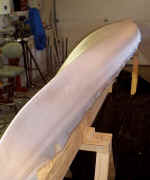 |
The 6oz glass cloth has been draped
over the hull and smoothed with a long drafting brush. There is no
epoxy "precoat," so the glass is laying directly on the wood. It is
very hard to reposition this way, so I tried to lay it flat the first
time. A few wrinkles are inevitable I guess, but brushing back and
forth at a 45 degree angle tends to flatten them out. Any
irregularities in the weave of the cloth are inconsequential, as they will
absolutely disappear when the cloth is wet out. Creases would be
another matter, as they may prevent the cloth from laying flat against the
wood. The cloth is only 30" wide (I got a real deal), so there is
not much extra at the wide part of the hull. You might say, "just
enough" . . . All is ready for my "teacher" friend, Dan Yarbrough's
arrival, later tonight.. |
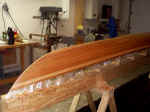 |
The glass is already completely wet
out and squeegeed. It took only 45 minutes to completely wet the
glass, place the four reinforcement strips at the stems, and glass those
as well. The reinforcements consist of 2 additional layers at the
bow and stern, for a total 18 oz layup at the high wear and abrasion
points. I cut the 6oz cloth used for the hull layup to create 6" and
4" wide bias-cut strips which wrapped easily around the stems fore and
aft. |
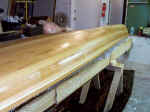 |
My friend Dan has been building
boats and surfboards for 40 years, and showed me the right way to perform
the layup. Mix the epoxy in generous quantities so you don't
keep running out, and then pour and spread. I mixed 24oz to wet the
whole hull in one shot. The next mix was 12oz and we were
done. Here is the aft end, Complete with 3 layers of glass at the
stern stem, just as at the bow - - The first added strip is 6" wide, and
the next is 4" wide - - They each run 4-5 feet up the keel, Per Rob Mack's
instructions for the Georgian Bay. |
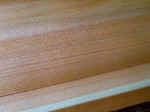 |
This is how the hull looks all over,
when you get close enough. Some epoxy ends up on the plastic drop
cloth, but the wood and glass sure get enough! Next come the
fill coats, starting tomorrow. The "Ding-All" epoxy that I used is
absolutely water-clear, very low viscosity, and has a very long pot
life, but it has one drawback - - Because of all the UV protectant in it,
it blushes like crazy. That means I have to wash it with a scrub
brush tomorrow before I add the first fill coat. That seems a small
price to pay, however . . . |
|
|
|
First Fill
Coat |
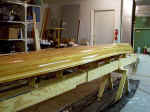 |
Next day . . . After Spending hours
blending the 4 glass reinforcement tapes at the bow and stern into the
main glass layer, and then sanding the entire hull, and then scrubbing it
with soap and water, I was able to put on the first fill coat. Dan
suggested I use a brush and really scrub the epoxy it into the weave,
which is what I did. I simply could not believe what a thin, really
brushed out coat of epoxy did to the hull's appearance! How many
coats are we supposed to put on??? |
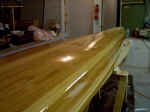 |
I did screw up during the tape
fairing operation, and sanded through the main cloth on the bottom center
near the stern. It is a 'quarter' sized ding that sure surprised me.
A 4" square patch is now in place, and it is already barely visible.
I'll have to now fair IT into the hull, and make it disappear. This
epoxy is such great stuff, I don't believe any problem is
irreversible. |
|
|
|
Sanding, Patching
Fill Coat |
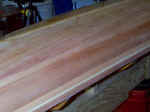 |
This looks like a step backward, but
you've got to trust the system. Here the first fill coat has been
sanded on one side of the hull. It looks like plain wood again, a
little hazy appearing, but strong as all get-out. It also makes a
funny noise when I sand it, almost like sanding plastic!
<G> I include these pictures of the sanding so I don't forget
how much work it is. The worst part is the bottom of the sheer
strip, where I let epoxy drip and forgot to remove it when it was "green."
I am paying the price now. |
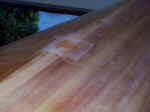 |
Here is the patch, it looks awful
after I feathered the edges. It should be invisible in another day,
after the next fill coat. I include this photo to remind me to be
more careful when feathering. One slip of the ROS and I bought
myself another job . . . more sanding! |
|
|
|
Second Fill
Coat |
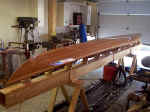 |
Well, after all that sanding, I get
to spend 45 minutes rolling on a second fill coat and then . . .
sand again. I used a brush for the first fill coat and it went on just a
hint heavier than I might have liked. I tried a foam roller today
and it too went on heavier than I would have liked. No problem, just
a few runs to sand as a consequence. Because of the viscosity of
epoxy, even this thin Ultra-Clear Ding-All, I guess it's hard to apply it
too thinly without overworking it. |
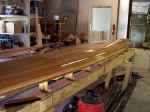 |
I still can't imagine all the fuss
about air bubbles in the epoxy. It could be the 82F temperatures or
the Ding-All epoxy, but any bubbles the roller left outgassed and flat
went away. I felt no need to "tip-off" this application with a foam
brush, as it self-leveled and had not a bubble to be
seen. |
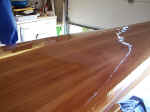 |
Now, where was that patch
again? There are lots of reflections in this pic, and this side
hasn't quite leveled yet, but I can no longer see the patch. I'm
sure there will be some sanding to do when all is said and done (There's
always more sanding to be done . . .), but that sucker has flat
disappeared for the moment! |
|
|
|
Third Sanding &
Fill Coat |
|
See Photos
Above |
The entire hull was sanded to
completely level it a third time. A third Fill coat of epoxy was
rollered on, quite thin this time, as not much correction was
needed. Both the sanded hull and the freshly glassed hull looked so
much like the above pictures, none were taken. It will be left in
this state to cure, and then the strongback will be "desengaged" and the
hull turned over to begin stripping the deck. The hull is now
complete until the inside of the hull is glassed - That occurs after the
deck is stripped and glassed, and the two halves of this boat are
disassembled to remove the forms. Next, please go to "Deck
Construction." |